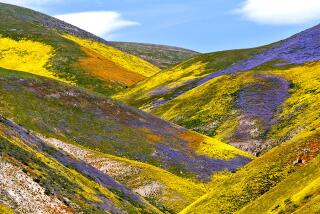Flowers That Bloom During the Summer
Hiding in the herb section at nurseries are several plants that are most useful in the garden (if not the kitchen) and are in full flower right now, or yet to bloom. That is one of their best attributes--that they flower in summer when so little else does.
One, in fact, is never out of flower. Jerusalem sage is not a true sage, but a Phlomis . It doesn’t smell like sage, but it does look the part. The leaves are long and narrow and gray-green, like those of the common culinary sage. Each leaf is outlined with soft white hairs that continue over the edge and cover the undersides with downy white.
The flowers are a very practical, unimpeachable soft yellow that gets along well with other colors.
Jerusalem sage is a bushy plant but distinctly vertical in form, with each stem leaning out, then turning up. The flowers are arranged in whorls that are evenly spaced along the stems. Beware, however, of its tendency to lean since it eventually occupies a great deal of space, about six feet across, and will crowd out anything in its way. It grows to about four feet in height. It can be pruned to keep it slightly smaller.
This is a Mediterranean plant of the garigue , native from the south of France to Palestine, and it tolerates considerable drought once its roots have done some growing. Try it on a hillside with pink and purple rockroses.
It can also tolerate regular garden watering. Mine grow right along with petunias, roses and other common fare.
Lion’s ear grows and flowers in a similar fashion. It was once a Phlomis too, though it has been renamed and is now called Leonotis leonurus , one of the more cuddly botanical names you’re likely to run across. It too is often sold in the herb section, being an African plant with a medicinal background.
Flowers come in whorls on spikes very similar to Jerusalem sage, but the flowers are a very fine orange, unusual in the plant world (it is an elegant cut flower). The leaves are long and narrow and a dark green. It grows to become a large bush, six feet tall by eight feet across. It can be cut back every year, though not by more than half. Hard pruning can kill it.
Why single out two plants for such praise? Because in my own garden they are two of my favorites--the first I like to point out to visitors and the first I suggest they also grow.
Two other summer-flowering perennials that I couldn’t garden without can also be found in herb sections at the nursery, but only rarely. They are scarce enough that I should perhaps not mention them at all, but they are too good to go unnoticed.
One is a true salvia, Salvia azurea grandiflora , also sold as S. pitcheri . It grows to about six feet by six feet in a season and the flowers are a true bright blue. Coming at summer’s end, the crisp blue flowers are a refreshing contrast to the hot, smoggy weather.
Another uncommon plant occasionally found in herb sections grows like a weed and is, in fact, a weed-- Verbascum thapsus . One of the mulliens, another ancient group of plants with medicinal (or perhaps magical) backgrounds, it can grow from a seedling to an eight-foot spire in one summer, becoming a giant exclamation mark in the landscape. The flowers on this huge spike aren’t much but the clump of foliage is very dramatic--huge, felty gray leaves.
My favorite mullien, however, is Verbascum chaxii , a name you should write on a piece of paper and carry everywhere until you find a plant. This verbascum has huge, dark green leaves, but the spikes, which grow from three to five feet tall, are covered with pure white flowers, and each flower has a collection of pistils and stamens inside that are a shocking and immodest purple. The plant flowers all summer, as elegant as can be, and returns faithfully from huge carrot-like roots every spring.






